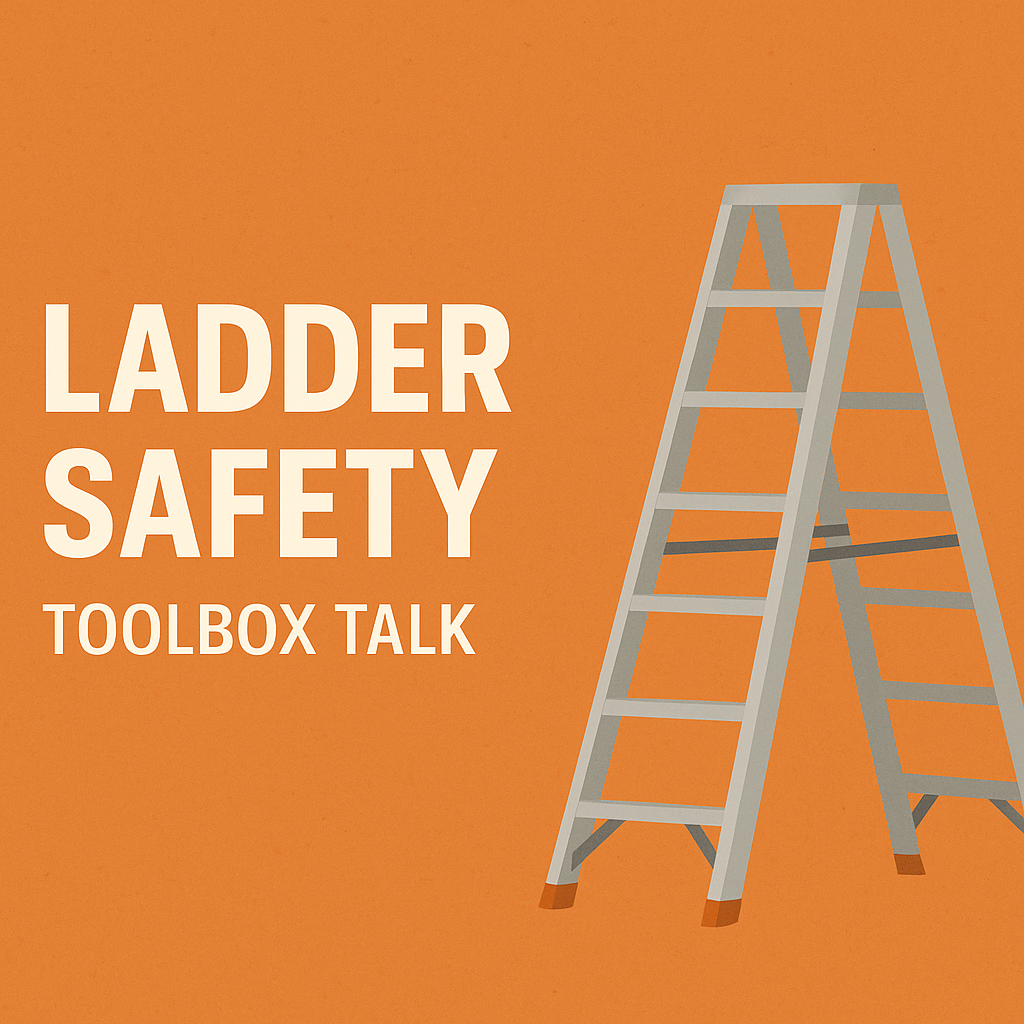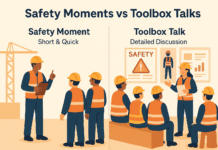
Ladder Safety TBT
Good morning team,
Today’s talk is about Ladder Safety — a topic that may seem simple, but ladders are involved in a huge number of workplace accidents every year.
Ladders are one of the most common tools on any site, whether we’re in construction, maintenance, warehousing, or even office facilities work. But because they’re so familiar, many people underestimate the dangers and skip basic safety steps.
The truth is — falls from ladders can cause serious injuries like broken bones, spinal damage, or even death, even from heights of just a few feet.
1. Why Ladder Safety Matters
- Falls from ladders are one of the leading causes of workplace injuries.
- Most accidents happen because the ladder was used incorrectly or in poor condition.
- Even a short fall can cause life-changing injuries.
2. Types of Ladders
- Step ladders – Self-supporting, used for short tasks.
- Extension ladders – Leaning type, adjustable length.
- Fixed ladders – Attached to structures.
- Platform ladders – With standing surface for longer tasks.
3. Common Ladder Hazards
- Slipping on rungs or steps.
- Ladder tipping over due to unstable setup.
- Overreaching and losing balance.
- Using damaged ladders.
- Setting up on uneven or slippery surfaces.
- Contact with overhead power lines.
4. Ladder Selection
- Choose the right type and height for the job.
- Never use a ladder that requires you to stand on the top rung or step.
- Check the ladder’s weight capacity — it must support you and your tools.
5. Ladder Inspection
Before using any ladder:
- Check for cracks, bent parts, missing rungs, or loose hardware.
- Ensure feet are intact and non-slip.
- For extension ladders, check ropes, pulleys, and locks.
- Tag defective ladders “Do Not Use” and remove from service.
6. Setting Up a Ladder Safely
- Place ladders on firm, level ground.
- Use the 4-to-1 rule for extension ladders: For every 4 units of height, the base should be 1 unit away from the wall.
- Secure ladders at the top or bottom to prevent slipping.
- Keep ladders away from doorways unless the door is locked or guarded.
7. Safe Ladder Use
- Maintain three points of contact at all times (two hands and one foot, or two feet and one hand).
- Face the ladder while climbing.
- Keep your belt buckle between the side rails — no leaning too far.
- Do not carry heavy loads up the ladder — use a hoist or hand line.
- Wear slip-resistant footwear.
8. Working Near Electricity
- Only use non-conductive ladders (fiberglass or wood) near electrical sources.
- Maintain safe clearance from power lines.
9. Do’s and Don’ts
✅ Do:
- Set up on stable, level ground.
- Have someone hold the ladder if necessary.
- Move the ladder instead of overreaching.
- Follow the ladder’s load rating.
❌ Don’t:
- Use a ladder if you’re tired or dizzy.
- Use makeshift ladders or climb on furniture.
- Leave tools on the ladder steps.
- Use a damaged ladder.
10. PPE for Ladder Work
- Safety boots with good grip.
- Hard hat when working below others or in construction zones.
- Gloves for grip and protection.
11. Real-Life Case Study
A maintenance worker used an extension ladder to change a light fixture. He placed it on a wet floor without securing the base. As he reached up, the ladder slipped, and he fell 2.5 meters, breaking his leg and dislocating his shoulder.
Lesson: Always secure ladders and check surface conditions before climbing.
12. Worker Engagement – Q&A
- What is the 4-to-1 rule for ladder setup?
- How many points of contact should you maintain while climbing?
- Why should you avoid overreaching?
13. Closing Words – Bringing It Back to the Start
Alright team, we started this morning by talking about how ladders seem simple but can be deadly if used incorrectly.
The safest ladder use comes down to three key things:
- Choose the right ladder for the job.
- Inspect it before every use.
- Use it properly with stable setup and safe climbing practices.
If something feels unsafe, don’t climb — fix the setup or find a safer method.
Remember: Falls are quick, unexpected, and often unforgiving — so take your time, set up right, and climb smart.
Stay alert, stay safe, and let’s have a productive day.
























